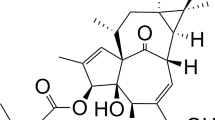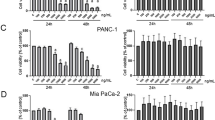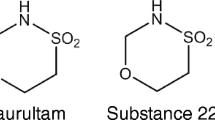Abstract
Allicin, an extremely active constituent of freshly crushed garlic, is produced upon reaction of substrate alliin with the enzyme alliinase (EC 4.4.1.4). Allicin has been shown to be toxic to several mammalian cells in vitro in a dose-dependent manner. In the present study this cytotoxicity was taken to advantage to develop a novel approach to cancer treatment, based on site directed generation of allicin. Alliinase was chemically conjugated to a monoclonal antibody (mAb) which was directed against a specific pancreatic cancer marker, CA19-9. After the CA19-9 mAb-alliinase conjugate was bound to targeted pancreatic cancer cells (MIA PaCa-2 cells), on addition of alliin, the cancer cell-localized alliinase produced allicin, which effectively induced apoptosis in MIA PaCa-2 cells. Specificity of anticancer activity of in situ generated allicin was demonstrated using a novel in vitro system—integrated discrete multiple organ co-culture technique. Further, allicin-induced caspase-3 expression, DNA fragmentation, cell cycle arrest, p21Waf1/Cip1 cyclin-dependent kinase inhibitor expression, ROS generation, GSH depletion, and led to various epigenetic modifications which resulted in stimulation of apoptosis. This approach offers a new therapeutic strategy, wherein alliin and alliinase-bound antibody work together to produce allicin at targeted locations which would reverse gene silencing and suppress cancer cell growth, suggesting that combination of these targeted agents may improve pancreatic cancer therapy.














Similar content being viewed by others
References
Burris HA, Moore MJ, Andersen J et al (1997) Improvements in survival and clinical benefit with gemcitabine as first-line therapy for patients with advanced pancreas cancer: a randomized trial. J Clin Oncol 15:2403–2413
Keleg S, Büchler P, Ludwig R et al (2003) Invasion and metastasis in pancreatic cancer. Mol Cancer 2:14. doi:10.1186/1476-4598-2-14
Shore S, Raraty MGT, Ghaneh P, Neoptolemos JP (2003) Chemotherapy for pancreatic cancer. Aliment Pharmacol Ther 18:1049–1069. doi:10.1046/j.1365-2036.2003.01781.x
Tawada K, Yamaguchi T, Kobayashi A et al (2009) Changes in tumor vascularity depicted by contrast-enhanced ultrasonography as a predictor of chemotherapeutic effect in patients with unresectable pancreatic cancer. Pancreas 38:30–35. doi:10.1097/MPA.0b013e318183ff73
Ilic D, Nikolic V, Nikolic L et al (2011) Allicin and related compounds: biosynthesis, synthesis and pharmacological activity. Facta Univ 9:9–20. doi:10.2298/FUPCT1101009I
Nakao A, Oshima K, Nomoto S et al (1998) Clinical usefulness of CA-19-9 in pancreatic carcinoma. Semin Surg Oncol 15:15–22. doi:10.1002/(SICI)1098-2388(199807/08)15:1<15:AID-SSU4>3.0.CO;2-Z
Makovitzky J (1986) The distribution and localization of the monoclonal antibody-defined antigen 19-9 (CA19-9) in chronic pancreatitis and pancreatic carcinoma. Virchows Arch B 51:535–544. doi:10.1007/BF02899058
Girgis MD, Olafsen T, Kenanova V et al (2011) CA19-9 as a potential target for radiolabeled antibody-based positron emission tomography of pancreas cancer. Int J Mol Imaging 2011:1–9. doi:10.1155/2011/834515
Miron T, Mironchik M, Mirelman D et al (2003) Inhibition of tumor growth by a novel approach: in situ allicin generation using targeted alliinase delivery. Mol Cancer Ther 2:1295–1301
Arditti F, Rabinkov A, Miron T et al (2005) Apoptotic killing of B-chronic lymphocytic leukemia tumor cells by allicin generated in situ using a rituximab-alliinase conjugate. Mol Cancer Ther 4:325–331
Carlsson J, Drevin H, Axen R (1978) Protein thiolation and reversible protein–protein conjugation. J Biochem 173:723–737
Miron T, Shin I, Feigenblat G et al (2002) A spectrophotometric assay for allicin, alliin, and alliinase (alliin lyase) with a chromogenic thiol: reaction of 4-mercaptopyridine with thiosulfinates. Anal Biochem 307:76–83. doi:10.1016/S0003-2697(02)00010-6
Yuen SH, Pollard GA (1954) Determination of nitrogen in agricultural materials by the nessler reagent. II micro-determinations in plant tissue and in soil extracts. J Sci Food Agric 5:364–369
Anthon GE, Barrett DM (2003) Modified method for the determination of pyruvic acid with dinitrophenylhydrazine in the assessment of onion pungency. J Sci Food Agric 83:1210–1213. doi:10.1002/jsfa.1525
Suman S, Pandey A, Chandna S (2012) An improved non-enzymatic “DNA ladder assay” for more sensitive and early detection of apoptosis. Cytotechnology 64:9–14. doi:10.1007/s10616-011-9395-0
Olive PL, Banáth JP (2006) The comet assay: a method to measure DNA damage in individual cells. Nat Protoc 1:23–29. doi:10.1038/nprot.2006.5
Lowry OH, Rosebrough NJ, Farr L, Randall RJ (1951) Protein measurement with the folin phenol reagent. J Biol Chem 193:265–275
Shechter D, Dormann HL, Allis CD, Hake SB (2007) Extraction, purification and analysis of histones. Nat Protoc 2:1445–1457. doi:10.1038/nprot.2007.202
Li AP (2007) In vitro evaluation of human xenobiotic toxicity : scientific concepts and the novel integrated discrete multiple cell co-culture (IdMOC) technology. ALTEX 25:43–49
Löwe J, Li H, Downing KH, Nogales E (2001) Refined structure of alpha beta-tubulin at 3.5 A resolution. J Mol Biol 313:1045–1057. doi:10.1006/jmbi.2001.5077
Gigant B, Wang C, Ravelli RBG et al (2005) Structural basis for the regulation of tubulin by vinblastine. Nat Lett 435:519–522. doi:10.1038/nature03566
Wu CC, Bratton SB (2013) Regulation of the intrinsic apoptosis pathway by reactive oxygen species. Antioxid Redox Signal 19:546–558. doi:10.1089/ars.2012.4905
Azadi HG, Riazi HG, Ghaffari SM et al (2009) Effects of Allium hirtifolium (Iranian shallot) and its allicin on microtubule and cancer cell lines. Afr J Biotechnol 8:5030–5037
Fuchs Y, Steller H (2011) Programmed cell death in animal development and disease. Cell 147:742–758. doi:10.1016/j.cell.2011.10.033
McElroy M, Kaushal S, Luiken GA et al (2008) Imaging of primary and metastatic pancreatic cancer using a fluorophore-conjugated anti-CA19-9 antibody for surgical navigation. World J Surg 32:1057–1066. doi:10.1007/s00268-007-9452-1
Kondo T, Yamauchi M, Tominaga S (2000) Evaluation of usefulness of in vitro drug sensitivity testing for adjuvant chemotherapy of stomach cancer. Int J Clin Oncol 5:174–182
Ostling O, Johnason K (1984) Microelectrophoretic study of radiation-induced DNA damages in individual mammalian cells. Biochem Biophys Res Commun 123:291–298
Barbouti A, Doulias T, Nousis L et al (2002) DNA damage and apoptosis in hydrogen peroxide-exposed jurkat cells: bolus addition versus continuous generation of H2O2. Free Radic Biol Med 33:691–702
Godard T, Deslandes E, Lebailly P et al (1999) Early detection of staurosporine-induced apoptosis by comet and annexin V assays. Histochem Cell Biol 112:155–161. doi:10.1007/s004180050402
Kindzelskii A, Petty H (1999) Ultrasensitive detection of hydrogen peroxide-mediated DNA damage after alkaline single cell gel electrophoresis using occultation microscopy and TUNEL labeling. Mutat Res Mol Mech Mutagen 426:11–22
Gupta J, Bhargava P, Bahadur D (2015) Fluorescent ZnO for imaging and induction of DNA fragmentation and ROS-mediated apoptosis in cancer cells. J Mater Chem B 3:1968–1978. doi:10.1039/C4TB01661K
Pelicano H, Carney D, Huang P (2004) ROS stress in cancer cells and therapeutic implications. Drug Resist Updat 7:97–110. doi:10.1016/j.drup.2004.01.004
Zhou Y, Hileman E (2003) Free radical stress in chronic lymphocytic leukemia cells and its role in cellular sensitivity to ROS-generating anticancer agents. Blood 101:4098–4104. doi:10.1182/blood-2002-08-2512.Supported
Senthil K, Aranganathan S, Nalini N (2004) Evidence of oxidative stress in the circulation of ovarian cancer patients. Clin Chim Acta 339:27–32. doi:10.1016/j.cccn.2003.08.017
Schumacker PT (2006) Reactive oxygen species in cancer cells: live by the sword, die by the sword. Cancer Cell 10:175–176. doi:10.1016/j.ccr.2006.08.015
Fruehauf JP, Meyskens FL (2007) Reactive oxygen species: a breath of life or death? Clin Cancer Res 13:789–794. doi:10.1158/1078-0432.CCR-06-2082
Ho B, Wu Y, Chang K, Pan T (2011) Dimerumic acid inhibits SW620 cell invasion by attenuating H2O2-mediated MMP-7 expression via JNK/C-Jun and ERK/C-Fos activation in an AP-1-dependent manner. Int J Biol Sci 7:869–880
Ding H, Han C, Guo D et al (2009) Selective induction of apoptosis of human oral cancer cell lines by avocado extracts via a ROS-mediated mechanism. Nutr Cancer 61:348–356. doi:10.1080/01635580802567158
Ryter W, Kim P, Hoetzel A et al (2007) Mechanism of cell death in oxidative stress. Antioxid Redox Signal 9:49–89
Oommen S, Anto RJ, Srinivas G, Karunagaran D (2004) Allicin (from garlic) induces caspase-mediated apoptosis in cancer cells. Eur J Pharmacol 485:97–103. doi:10.1016/j.ejphar.2003.11.059
Park SY, Cho SJ, Kwon HC et al (2005) Caspase-independent cell death by allicin in human epithelial carcinoma cells: involvement of PKA. Cancer Lett 224:123–132. doi:10.1016/j.canlet.2004.10.009
Belmokhtar C, Hillion J, Bendirdjian SE (2001) Staurosporine induces apoptosis through both caspase-dependent and caspase-independent mechanisms. Oncogene 20:3354–3362
Mooney LM, Al-Sakkaf KA, Brown BL, Dobson PRM (2002) Apoptotic mechanisms in T47D and MCF-7 human breast cancer cells. Br J Cancer 87:909–917. doi:10.1038/sj.bjc.6600541
Armstrong J, Steinauer K, Hornung B et al (2002) Role of glutathione depletion and reactive oxygen species generation in apoptotic signaling in a human B lymphoma cell line. Cell Death Differ 9:252–263. doi:10.1038/sj.cdd.4400959
Franco R, Cidlowski JA (2009) Apoptosis and glutathione: beyond an antioxidant. Cell Death Differ 16:1303–1314. doi:10.1038/cdd.2009.107
Rahman I, Marwick J, Kirkham P (2004) Redox modulation of chromatin remodeling: impact on histone acetylation and deacetylation, NF-κB and pro-inflammatory gene expression. Biochem Pharmacol 68:1255–1267. doi:10.1016/j.bcp.2004.05.042
Simboeck E, Sawicka A, Zupkovitz G et al (2010) A phosphorylation switch regulates the transcriptional activation of cell cycle regulator p21 by histone deacetylase inhibitors. J Biol Chem 285:41062–41073. doi:10.1074/jbc.M110.184481
Su B, Xiang L, Su J et al (2012) Diallyl disulfide increases histone acetylation and P21WAF1 expression in human gastric cancer cells in vivo and in vitro. Biochem Pharmacol 1:1–10. doi:10.4172/2167-0501.1000106
Xu WS, Parmigiani RB, Marks PA (2007) Histone deacetylase inhibitors: molecular mechanisms of action. Oncogene 26:5541–5552. doi:10.1038/sj.onc.1210620
Mitani Y, Oue N, Hamai Y (2005) Histone H3 acetylation is associated with reduced p21WAF1/CIP1 expression by gastric carcinoma. J Pathol 205:65–73. doi:10.1002/path.1684
Clayton AL, Rose S, Barratt MJ, Mahadevan LC (2000) Phosphoacetylation of histone H3 on c-fos- and c-jun-associated nucleosomes upon gene activation. EMBO J 19:3714–3726
Lo WS, Trievel RC, Rojas JR et al (2000) Phosphorylation of serine 10 in histone H3 is functionally linked in vitro and in vivo to Gcn5-mediated acetylation at lysine 14. Mol Cell 5:917–926. doi:10.1016/S1097-2765(00)80257-9
Cheung P, Tanner KG, Cheung WL et al (2000) Synergistic coupling of histone H3 phosphorylation and acetylation in response to epidermal growth factor stimulation. Mol Cell 5:905–915
Varier RA, Timmers HTM (2011) Histone lysine methylation and demethylation pathways in cancer. Biochim Biophys Acta 1815:75–89. doi:10.1016/j.bbcan.2010.10.002
Hung SW, Mody H, Marrache S et al (2013) Pharmacological reversal of histone methylation presensitizes pancreatic cancer cells to nucleoside drugs: in vitro optimization and novel nanoparticle delivery studies. PLoS ONE 8:1–14. doi:10.1371/journal.pone.0071196
Pavletich N (1999) Mechanisms of cyclin-dependent kinase regulation: structures of cdks, their cyclin activators, and cip and INK4 inhibitors 1, 2. J Mol Biol 287:821–828. doi:10.1006/jmbi.1999.2640
Molinari M (2000) Cell cycle checkpoints and their inactivation in human cancer. Cell Prolif 33:261–274. doi:10.1046/j.1365-2184.2000.00191.x
Kuriyama R, Sakai H (1974) Role of tubulin-SH groups in polymerization to microtubules. J Biochem 76:651–654
Li M, Ciu J, Ye Y et al (2002) Antitumor activity of Z-ajoene, a natural compound purified from garlic : antimitotic and microtubule-interaction properties. Carcinogenesis 23:573–579
Xiao D, Pinto JT, Soh J et al (2003) Induction of apoptosis by the garlic-derived compound S-allylmercaptocysteine (SAMC) is associated with microtubule depolymerization and c-Jun NH2-terminal kinase 1 activation. Cancer Res 63:6825–6837
Nishida E, Kobayashi T (1977) Relationship between tubulin SH groups and bound guanine nucleotides. J Biochem 81:343–347
Rabinkov A, Miron T, Konstantinovski L et al (1998) The mode of action of allicin: trapping of radicals and interaction with thiol containing proteins. Biochim Biophys Acta 1379:233–244. doi:10.1016/S0304-4165(97)00104-9
Cotter TG (2009) Apoptosis and cancer: the genesis of a research field. Nat Rev 9:501–507. doi:10.1038/nrc2663
Acknowledgments
This work was supported in part by Mumbai University Grant (097). We appreciate Sophisticated Analytical Instrumentation Facility, Indian Institute of Technology, Bombay, for Flow cytometry analysis, BD Biosciences for providing Matrigel, and Dr. Vibha Verma for technical assistance.
Author information
Authors and Affiliations
Corresponding author
Ethics declarations
Conflict of interest
Dr. Albert P. Li is the inventor of IdMOC and CEO of AP Sciences Inc., Columbia, MD, USA which commercializes IdMOC culture plates.
Rights and permissions
About this article
Cite this article
Chhabria, S.V., Akbarsha, M.A., Li, A.P. et al. In situ allicin generation using targeted alliinase delivery for inhibition of MIA PaCa-2 cells via epigenetic changes, oxidative stress and cyclin-dependent kinase inhibitor (CDKI) expression. Apoptosis 20, 1388–1409 (2015). https://doi.org/10.1007/s10495-015-1159-4
Published:
Issue Date:
DOI: https://doi.org/10.1007/s10495-015-1159-4




